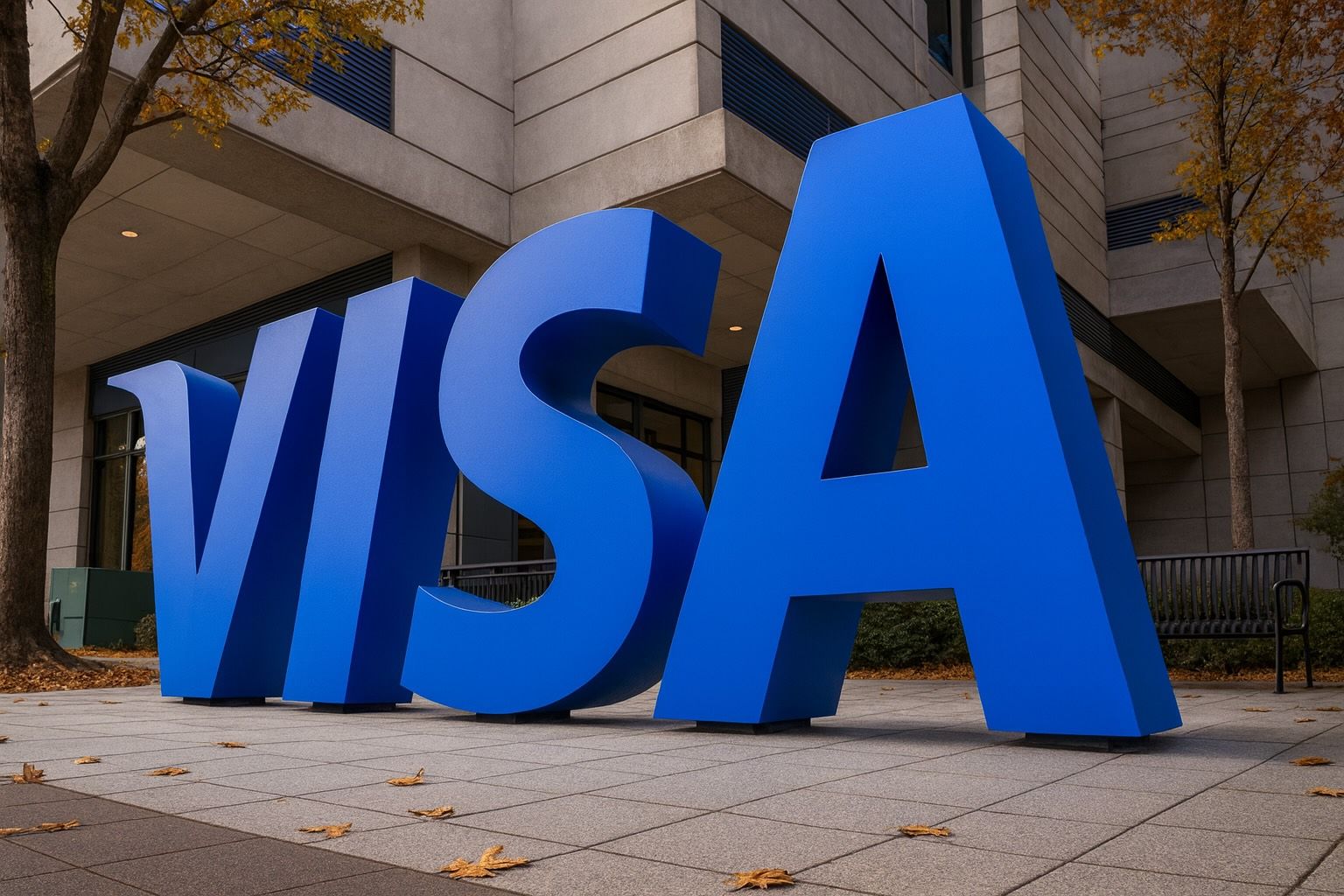- Stock Price: Around $345 per share on Oct 23, 2025 [1], roughly flat on the day and up about 10% year-to-date. The stock has traded in the mid-$300s recently (52-week range ~$280–$375) [2].
- Recent Earnings: Visa’s Q3 FY2025 (ended June) beat expectations – revenue jumped 14% YoY to $10.17 billion and EPS was $2.98 [3]. Analysts expect Q4 results (due Oct 28) around $2.96 EPS on $10.60B revenue [4]. The company’s full-year outlook remains cautious (single-digit revenue growth).
- Analyst Ratings: Wall Street is bullish. The average 12-month price target is about $399 (≈15% above today) [5]. Major banks are raising targets – e.g., Bank of America sees $410 [6] and Wells Fargo initiated coverage (20 Oct) with an Overweight rating and $412 target [7]. Analysts cite Visa’s massive network and resilient consumer spending as long-term positives.
- Fintech Initiatives: Visa is aggressively innovating. It’s piloting stablecoin-funded payments – letting banks pre-fund Visa Direct accounts with crypto (e.g. USDC stablecoins) for instant cross-border transfers [8]. Visa’s product head Mark Nelsen noted the new “Genius Act” stablecoin law “changed everything,” enabling this trial [9]. At the same time, Visa unveiled a “Trusted Agent Protocol” to secure AI-driven shopping bots on merchant sites [10]. These moves – along with partnerships with travel tech (HotelRunner) and fintech firms – signal Visa’s push into new digital payment frontiers [11] [12]. (As one analyst put it, “Visa is aggressively investing in new payment technologies,” fueling optimism for future growth [13].)
- Legal & Regulatory: Visa faces antitrust scrutiny. The U.S. Justice Department has sued Visa over alleged debit-card competition issues (Visa calls the claims “meritless” [14]). This news briefly knocked shares down ~3% in mid-Oct [15]. Separately, Visa agreed to pay $119.7 million (out of a $199.5M settlement) in a long-running merchant class-action on chargebacks [16]. Neither case admits wrongdoing, and Visa is contesting or settling to clear the way. Investors will watch these developments closely as a potential overhang.
- Macro Factors: U.S. economic trends are favorable for Visa. Consumer spending has held up and wages are rising, keeping card volumes strong [17]. The Fed is widely expected to cut rates soon, which could boost borrowing and spending. (Bank of America now forecasts a Fed rate cut as early as October 2025 [18].) Lower rates tend to benefit credit and debit volume, a tailwind for Visa. However, data lags (due to a government shutdown) have economists warning the Fed is “flying blind” on the labor market [19]. Any signs of slowing consumer credit growth or rising defaults could rattle payment stocks like Visa.
- Valuation: Visa trades at a premium multiple (~33× forward EPS [20]) above the S&P’s ~18–20×. It’s cheaper than Mastercard (~37×) but far richer than fintech peers like PayPal (~14×) [21]. Investors seem to accept the lofty valuation on Visa’s growth prospects, but some analysts caution it requires sustained volume growth.
What Experts Say: Visa executives and analysts remain upbeat on the payments boom. CEO Ryan McInerney, commenting on Q3 results, noted tariffs and inflation had “no meaningful impact” on consumer spending [22]. Mark Nelsen (Visa product head) highlighted regulatory clarity enabling new stablecoin trials [23], while Visa’s Jack Forestell (CPO) emphasized that merchants and card networks must ensure AI agents are “trusted” customers [24]. On the sell-side, firms like Wells Fargo describe Visa as one of the “Fab 5 of Fintech,” and have initiated coverage on the stock [25].
The Outlook: In summary, Visa (V) sits at the intersection of strong consumer payment trends and cutting-edge fintech innovation. Recent quarterlies show robust growth, and experts forecast mid-to-high single digit growth in the near term. Going forward, the stock’s performance will hinge on execution: sustained spending volumes, successful rollout of crypto/AI initiatives, and navigating legal challenges. Bullish analysts point to Visa’s powerful network effects and ongoing digital push as reasons it can continue outperforming. Of course, any signs of consumer fatigue or adverse regulation could temper gains. For now, with shares in the mid-$300s and upside in sight (12-month targets near $400), many investors are optimistic. Visa’s next earnings report on Oct 28 will be a key catalyst.
Sources: Recent stock data and forecasts [26] [27] [28] [29]; fintech initiative and executive quotes [30] [31] [32] [33]; legal news [34] [35]; analyst commentary and market context [36] [37] [38].
References
1. stockanalysis.com, 2. stockanalysis.com, 3. www.marketbeat.com, 4. www.marketbeat.com, 5. www.nasdaq.com, 6. www.nasdaq.com, 7. www.tipranks.com, 8. www.reuters.com, 9. www.reuters.com, 10. venturebeat.com, 11. ts2.tech, 12. venturebeat.com, 13. ts2.tech, 14. www.reuters.com, 15. www.reuters.com, 16. www.reuters.com, 17. ts2.tech, 18. www.reuters.com, 19. www.reuters.com, 20. www.marketbeat.com, 21. ts2.tech, 22. ts2.tech, 23. www.reuters.com, 24. investor.visa.com, 25. www.tipranks.com, 26. stockanalysis.com, 27. www.nasdaq.com, 28. www.tipranks.com, 29. www.marketbeat.com, 30. www.reuters.com, 31. www.reuters.com, 32. venturebeat.com, 33. investor.visa.com, 34. www.reuters.com, 35. www.reuters.com, 36. ts2.tech, 37. www.reuters.com, 38. www.reuters.com







